by tmoffett | Oct 18, 2010 | Color, Landscape, Photographic Philosophy
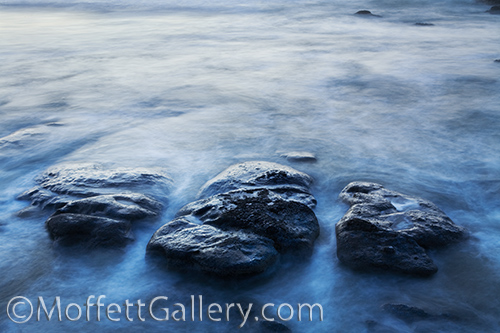
Pacific Wonder
My best photographs are made when I am in a “zone,” so to speak. I am oblivious to the many distractions around me and am in tune with my subject matter. In the landscape, I am in touch with nature. I can feel the crisp air, smell the scents of nature, hear every sound from the rushing water to the birds chirping. It is an experience. The images created are a reflection of the experience. Hopefully they create a visual and emotional experience for the viewer.
Technique plays a very important part in creating the visual experience, however it is not something that I am constantly thinking about. It has become a part of me. It just happens. Otherwise it would possibly get in the way of the creative experience. In the formative years of my photographic career I spent many hours honing technique. I studied. I photographed. I printed in the darkroom. I photographed more. I read more. I studied more. I worked harder. I made mistakes. I tried to learn from my mistakes. Photography slowly became a part of me.
I continue to read and study. I love working with other photographers. But when I photograph, I photograph. The technique just happens. I don’t question what I do. I just do it. I often am amazed at the results. When I listen to my inner self, good things happen. My own feelings are evident in the images created in this manner. It is as though I am opening up my innermost feelings and passions to the entire world, yet there is enough room for personal interpretation that the viewer may see something completely different. I can see myself in my images while others may not. I like it that way. For that reason I will rarely discuss the “meaning” of my images. I prefer the engaged viewer to determine meaning. I feel better that way. And that to me is what photography is all about. Feeling.
by tmoffett | Oct 16, 2010 | Color, Composition, Landscape, Photographic Philosophy, Uncategorized
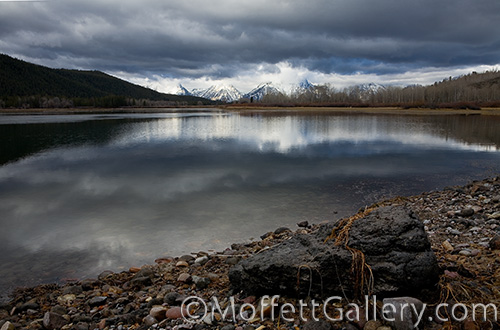
The Tetons
Landscape photography is so much more than just snapping pictures of scenic areas. We must deal with finding a the scene, analyzing composition and working with the light that nature gives us. That doesn’t mean that we make photographs of scenic places under the light that is there when we conveniently decide to be there, wherever there is. It means that we may get up at 4:00 AM and go out in the winter cold in order to arrive and be ready when the morning light first breaks over the horizon. It may mean that we suffer in the late summer heat to find our location and composition and then patiently wait for the setting sun to deliver the quality of light needed to create the mood in our photograph to say what we want it to say. Some days I will set up and wait, only to have the light fizzle out and not deliver. That’s okay. It’s just part of being a photographer.
Learning your craft, really learning it, is a major part of becoming an artist. We must understand the technical aspects of the camera and composition first, and then when photographing from the heart we are able to create masterpieces without having to think logically during the process. We can truly work on an emotional level only when we can work on the technical level without thinking about it. It must become a part of us. I see many students who refuse to learn and master the technical and then wonder why their photographs do not have the emotional impact that they would like. Photography is a blend of art and science, and we must comprehend both if we are to master our craft.
by tmoffett | Oct 14, 2010 | Color, Composition, Landscape, Uncategorized
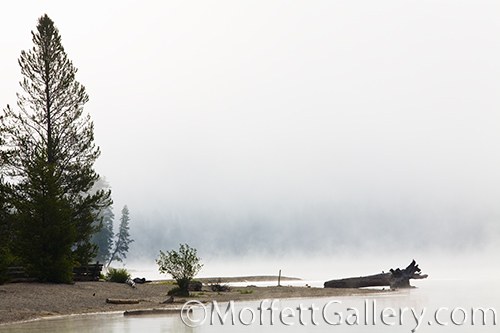
Foggy Morning, Redfish Lake
The Stanley are is one of my favorites! On one late summer morning I was treated to a heavy fog in the entire valley. As I drove toward Redfish Lake, the fog thinned out a bit so that the foreground was visible, but the trees across the lake were nearly gone. It was a beautiful sight. The fog was beginning to lift, so I didn’t have much time to photograph, but pausing for a moment first to take it all in and feel the surroundings (a necessity for me before photographing), I then proceeded to set up camera and tripod. I first made some images of the boats in the marina, then turned my attention toward the shoreline. I found this small peninsula with a large log, surrounded mostly by the morning fog, which provided the weight to balance with the trees at the left edge of the composition. The feeling of stillness, calm and peace prevailed with just enough detail to move the eye throughout the image to keep it interesting and hold attention. I love the trees just showing through the fog enough to create a bit of mystery. It was a great morning to be out enjoying God’s great creations.
by tmoffett | Oct 13, 2010 | Color, Landscape
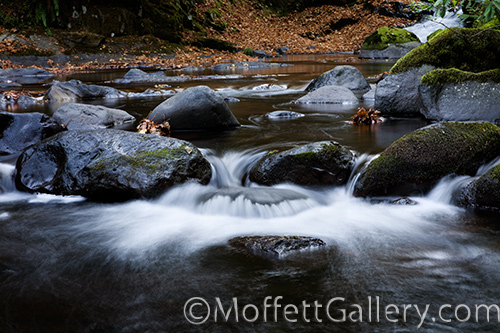
Fall on Sweet Creek
Sweet Creek is a wonderful place to relax and enjoy nature. If you like the sound of rushing water, this is the place. It is loaded with one waterfall after another. It is definitely one of the prettiest places I have ever visited. Some days the words just don’t flow, and today is one of those days, so just enjoy the image!
by tmoffett | Oct 12, 2010 | Color, Landscape, Photo tips
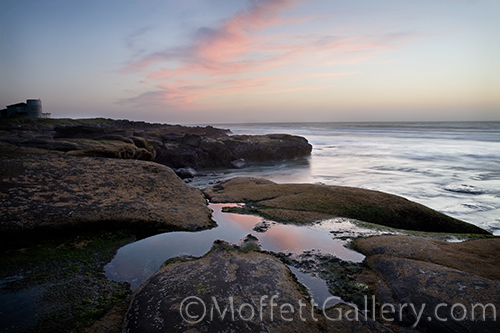
Sunset Reflection, Yachats, Oregon
Light. Photography is all about light. Not just intensity, but more importantly quality. Photography means painting with light. As photographers, not understanding light is like a painter who doesn’t understand paint! Unfortunately there are too many photographers without a basic understanding of their craft.
My absolute favorite time to photograph the landscape is the 30 minutes after sunset. Why? because of the quality of light that is prevalent at that time. The light is soft, warm and moody. There is a balance between light on the foreground and the light in the evening sky that is wonderful! There is still direction to the light, yet it is still very controllable. The light intensity falls off fast, so there is not a lot of working time, so you must be ready and not expect to get a lot of exposures in, but the ones that you do get are great ones. My goal when I go out to shoot is one image. I may set up my equipment and photograph the same scene multiple times until the light is completely gone. This way, I can see the progress of the light from sunset through the glow of afterlight. This image went from great to gone in less than five minutes. If I had not been ready, I would have missed it.
Some of my other favorite lighting conditions are overcast, especially for landscape photography, reflected light for both landscapes and portraits and open shade, particularly for portraits. Learning the characteristics of light is critical to your success as a photographer.
by tmoffett | Oct 11, 2010 | Black and White, Composition, Landscape, Photographic Philosophy
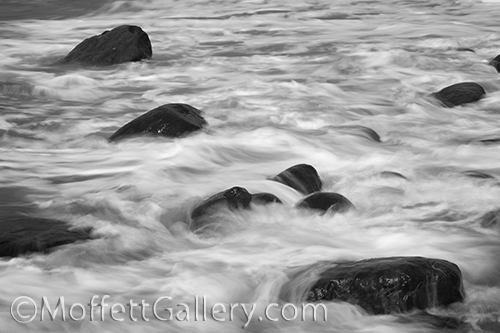
Rocky Shoreline, 408 Trail, Yachats, Oregon
Shorelines is a portfolio of photographs that I have been working on for about a year now. It is all about water and land interaction along shorelines. Both ocean and lake shorelines are included in the series. I spend a lot of time in the outdoors, not only photographing, but fishing and just enjoying nature. I have been intrigued with water and land interactions for a long time. I have noticed both erosion and new life along the lakes I have camped at. Along the ocean I see the changes that happen with rising and ebbing tides. The calm waters in a tide pool or the rough waters of a stormy sea. It seems that the waters of the deep have little change, but at the shoreline the change is constant.
I have visited the same locations multiple times and never found the same thing twice. Ona Beach along the Oregon Coast, for one, in June had some incredible rock formations covered in moss along the shore, but in October those rocks are completely covered with sand. This occurs due to the shifting sands throughout the year. The light on a clear summer day will create a totally different look and feel than I will find on a stormy fall evening.
When photographing along a shoreline, I like to keep a sense of stability by maintaining some element in crisp focus, while letting other area blur with the motion of the water. In this image, the rocks protruding from the water provide that stability to the image, while the fast moving waters create a sense of movement and flow. The busyness of a stormy sea in contrast to the stability of solid rock. I can read the story of my life in the photographs that I create, but instead of telling my story, I want you to see yours.








Recent Comments